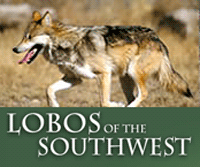Arizona Daily Sun (Original) Posted January 24, 2016 by Emery Cowan
GILA NATIONAL FOREST -- It took only a millisecond after wildlife officials opened the door of his crate for M1296, a male Mexican gray wolf, to dart out onto a smooth sheet of sun-crusted snow.
He started at a sprint but after 30 yards or so, 1296 slowed down to a walk and began weaving and stumbling, looking perplexed. It was as if he had just landed on another planet.
A few minutes later, though, the handsome, tan and cinnamon-colored wolf found his bearings and was off, loping through the ponderosa pines of New Mexico's Gila National Forest.
The behavior of 1296 wasn't surprising to federal biologists watching him. It had been quite the day for the nearly 4-year-old canid.
Just a few hours before, the Mexican gray wolf had been spotted by federal wildlife officials scouting the forest in a helicopter. After a 16-minute pursuit, 1296 was darted, anesthetized and scooped up to be checked, measured and collared as part of the U.S. Fish and Wildlife Service's annual count of the endangered species.
It's a labor-intensive, multi-step process that the federal wildlife agency, along with tribal and state partners, conducts every year to monitor the progress of the wolves' recovery in the Southwest.
Nearly completely exterminated by humans in the early and mid-1900s, the Mexican gray wolf population was down to seven wolves from three lineages by the 1970s. Since then, the number of wolves that roam through about 7,000 square miles near the New Mexico-Arizona state line has grown to at least 110, according to last year's count. The results of this count, which runs through Feb. 3 will give the most up-to-date status of the population.
In addition to counting the wolves, the interagency field team also temporarily captures a certain number of the wolves to examine them, give them vaccines, draw blood, measure their bodies and fit them with tracking collars. Doing so provides scientists and wildlife managers important information about where the wolves are roaming, which informs their decisions on areas for future reintroductions. The information also alerts scientists to signs of inbreeding in the wolf population and helps them monitor predation of large game and livestock.
Anatomy of a wolf count
About 20 people from local, state, federal and tribal agencies are helping out on the Mexican gray wolf counts this year. The team is stationed in a cluster of trailers just outside the small town of Alpine in the White Mountains. The counts always happen in the winter because that is when the population is most stable — young wolves have dispersed from their home packs to find a mate and biologists can better determine how many pups born in the spring have survived their first year, said Jeff Humphrey, spokesman for the U.S. Fish and Wildlife Service. Snow also slows the animals down when they are being tracked by helicopter and the white ground cover makes them easier to spot.
Each day, the interagency field team focuses on counting a few packs, or extended family groups, and prioritizes certain wolves for capture. In the case of 1296, biologists wanted to fit him with a GPS collar, instead of one that uses radio waves, said Sherry Barrett, Mexican wolf recovery coordinator for the U.S. Fish and Wildlife Service.
A helicopter and a spotting plane tag team the count and capture effort. Once they spot the wolves, the helicopter flies just above the treetops as a designated biologist, hooked into a body harness, leans out of the open doorway to dart the wolf. It took two eight-minute pursuits with a five-minute rest in between before Ole Alcumbrac, project veterinarian, was able to nab 1296.
After the anesthesia from the dart kicked in, the wolf was muzzled, his front and back legs tied and then he was loaded into Alcumbrac's arms to be flown back to the team's Alpine base.
Inside the trailer, where a conference table doubled as the examination surface, the 74-pound wolf was laid down while biologists crowded around. They administered vaccines, took the animal's temperature and pulse, drew blood and measured its paws, body and teeth.
While the veterinarians and biologists worked, Julia Smith, a biologist with the Arizona Game and Fish Department, tracked down 1296's history. In 2013 when he was a year old, the wolf was trapped by a hunter in New Mexico. When U.S. Fish and Wildlife Service officials arrived, he looked terrible, with broken teeth and abrasions, Smith said. She doubted he would survive. But he did and has been roaming across western New Mexico ever since. His first mate died in 2014, but he found another lady friend just this year. Biologists hope they'll mate this spring.
After about 40 minutes, the processing was done and the still groggy wolf was carefully loaded into a crate for the journey back home.
The long drive out to 1296's territory wound through ponderosa pines and meadows dotted with scrubby brush. Cows grazing along the route were a reminder of the fragile balance between the wolves' recovery and livestock grazing.
The wolf was released in an opening of scrubby grass and knee-high shrubs close to where he was found hours before. As the canid trotted off into the trees, biologists had a good feeling he wouldn't be alone for long — as the truck carrying 1296 neared the point of release, another wolf was seen running through the trees. More than likely, it was his mate, anxiously awaiting her partner's return, Barrett said.





